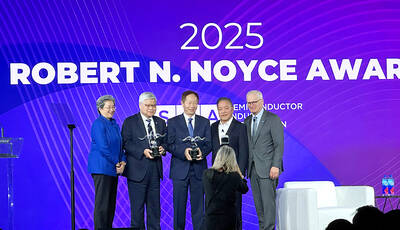Cattle rancher Bobby Helmers cranes to listen as the blades of his six giant wind turbines slice through the air in the same Texas fields that once echoed with the sounds of oil pumps.
Like J.R. and Bobby Ewing, lead characters in the hit 1970s and 1980s TV series Dallas, Helmers hosted oil wells on his land for decades, but with renewable energy increasingly viable even in the petroleum-rich Lone Star State, the 79-year-old is among several ranchers who have plugged their pumps and made the shift to wind power.
He still marvels at how little noise comes from the massive turbines, each of which cuts a 120m diameter over the property, and the taste of modernity that they brought three years ago to a traditional cattle ranch owned by his wife’s family for three generations.

Photo: AFP
“The Stetsons and the horses have been replaced by caps and pickups,” Helmers said.
However, the cows remain on the ranch in San Angelo, about 400km southwest of Dallas.
The Helmers and an employee raise 125 head of Brangus, a hybrid between the Angus breed prized for its tender beef and Brahman known for their resistance to heat, but today, half of the ranch’s operating revenue comes from the turbines.
A few kilometers away, in a small building set among juniper bushes and cacti, Kevin DeFoor manages about 10 workers tasked with maintaining the wind farm of 76 turbines, including those on the Helmers’ land.
“The region developed itself thanks to agriculture, ranching and oil,” said 48-year-old DeFoor, an employee of French energy giant Engie SA, which manages the wind farm.
It took a while before the area native realized that local riches were not just found in the soil.
In 2007, DeFoor, a former prison warden, became the first in his family to work in the wind energy sector — and he has been raving about the area’s wind consistency ever since.
“Our turbines turn 50 percent of the time,” DeFoor said, in what he called a “great performance” for the US wind sector.
US President Joe Biden’s call for a clean energy revolution has resonated in Texas. The state known for its fossil fuels has invested heavily since the early 2000s to become the nation’s top wind energy producer and second-biggest producer of solar energy.
“Contrary to popular belief, Texas governor [and later US president] George W. Bush, and then his successor Rick Perry didn’t want Texas to be solely reliant on oil,” said Joshua Long, an associate professor of environmental studies at Southwestern University near Austin. “They viewed Texas as ‘the Energy State,’ with a diversity of energy sources.”
As a result, fossil fuels and renewables have coexisted in Texas for years.
It is not out of environmental conviction that Helmers flipped from oil to wind.
Installed in the early 1990s, his oil pumps began producing steadily shrinking returns, and after about three decades, the contractor operating them eventually threw in the towel.
In a slice of good fortune, the Infinity Renewables group arranged to meet with Helmers and his neighbors in a nearby restaurant, where the potential royalties from wind energy the suitors described convinced Helmers to make the switch.
Oil reserves and profits can drop, he said, while “in wind, the production is stable,” and profit shares rise over the years as the investments are amortized.
A full decade passed between the initial negotiations and construction of the first turbine on Helmers’ property. By then, Engie had bought Infinity Renewables, and the technology had improved.
“The turbines were supposed to be 1.5 megawatt-hours, and they are now 2.625” megawatt-hours, boosting revenues, the jeans-clad cowboy said in his living room, where hunting trophies adorn the walls.
While his oil income fluctuated due to market volatility, Helmers now appreciates the steadier, although undisclosed, new income.

Shiina Ito has had fewer Chinese customers at her Tokyo jewelry shop since Beijing issued a travel warning in the wake of a diplomatic spat, but she said she was not concerned. A souring of Tokyo-Beijing relations this month, following remarks by Japanese Prime Minister Sanae Takaichi about Taiwan, has fueled concerns about the impact on the ritzy boutiques, noodle joints and hotels where holidaymakers spend their cash. However, businesses in Tokyo largely shrugged off any anxiety. “Since there are fewer Chinese customers, it’s become a bit easier for Japanese shoppers to visit, so our sales haven’t really dropped,” Ito

The number of Taiwanese working in the US rose to a record high of 137,000 last year, driven largely by Taiwan Semiconductor Manufacturing Co’s (TSMC, 台積電) rapid overseas expansion, according to government data released yesterday. A total of 666,000 Taiwanese nationals were employed abroad last year, an increase of 45,000 from 2023 and the highest level since the COVID-19 pandemic, data from the Directorate-General of Budget, Accounting and Statistics (DGBAS) showed. Overseas employment had steadily increased between 2009 and 2019, peaking at 739,000, before plunging to 319,000 in 2021 amid US-China trade tensions, global supply chain shifts, reshoring by Taiwanese companies and

Taiwan Semiconductor Manufacturing Co (TSMC, 台積電) received about NT$147 billion (US$4.71 billion) in subsidies from the US, Japanese, German and Chinese governments over the past two years for its global expansion. Financial data compiled by the world’s largest contract chipmaker showed the company secured NT$4.77 billion in subsidies from the governments in the third quarter, bringing the total for the first three quarters of the year to about NT$71.9 billion. Along with the NT$75.16 billion in financial aid TSMC received last year, the chipmaker obtained NT$147 billion in subsidies in almost two years, the data showed. The subsidies received by its subsidiaries —

Taiwan Semiconductor Manufacturing Co (TSMC) Chairman C.C. Wei (魏哲家) and the company’s former chairman, Mark Liu (劉德音), both received the Robert N. Noyce Award -- the semiconductor industry’s highest honor -- in San Jose, California, on Thursday (local time). Speaking at the award event, Liu, who retired last year, expressed gratitude to his wife, his dissertation advisor at the University of California, Berkeley, his supervisors at AT&T Bell Laboratories -- where he worked on optical fiber communication systems before joining TSMC, TSMC partners, and industry colleagues. Liu said that working alongside TSMC